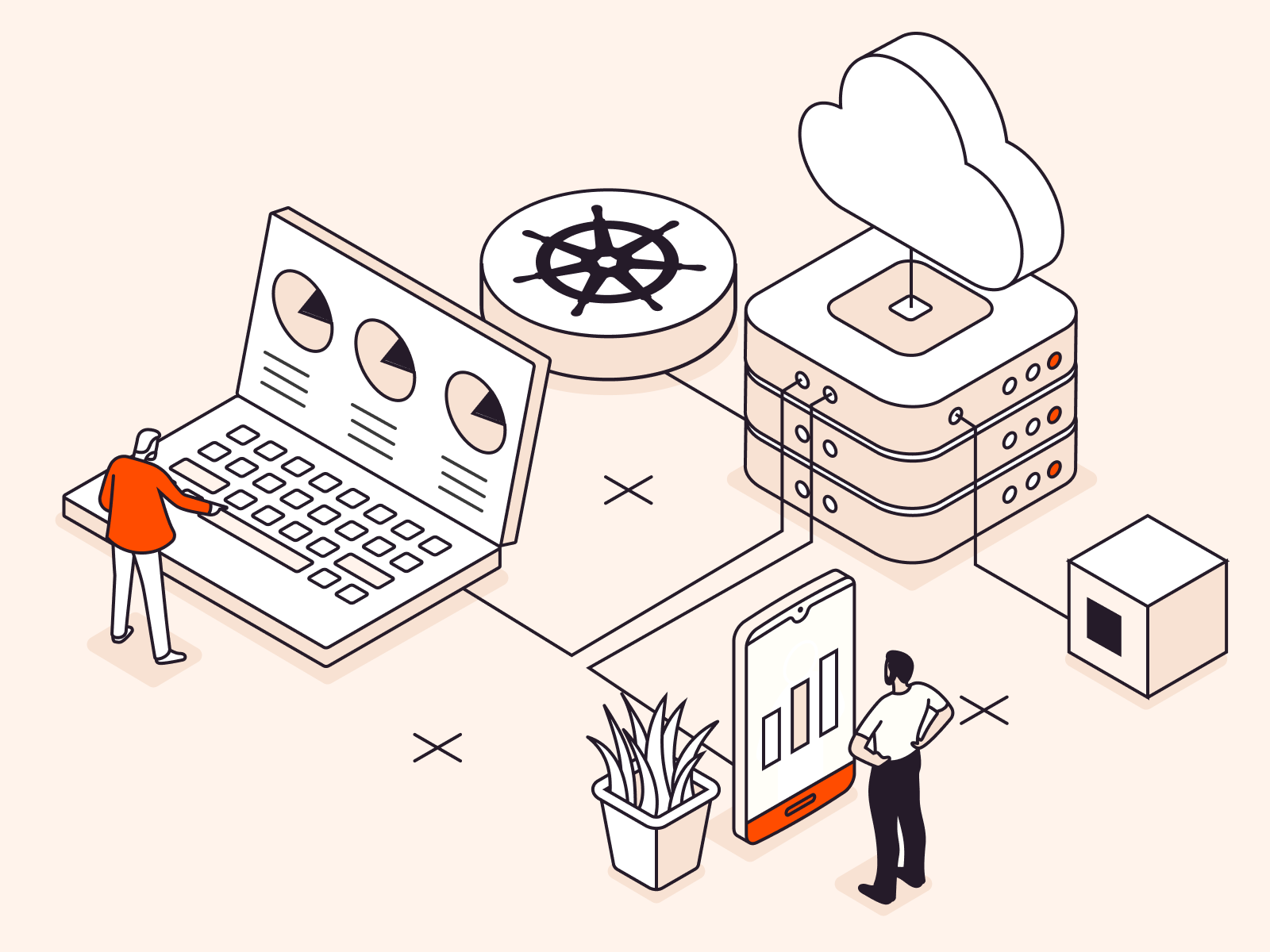
When you decide to use Kubernetes to run your applications, your first decision should typically be whether to opt for a managed Kubernetes service or self-hosted Kubernetes. These are two different ways to run K8s clusters, and they differ in many ways, from infrastructure provisioning to day-to-day maintenance. This article will guide you through the differences between these two ways of running Kubernetes. By the end, you’ll have a detailed understanding of the key differences between managed and self-managed Kubernetes, so you can make an informed decision about what’s best for your use case.
Please note that this article focuses on the technical and administrative side of managing K8s, rather than a financial (TCO) comparison.
Key Differences: Managed vs. Self-Managed K8s Cluster
The chart below summarizes these key differences between a self-hosted and a managed Kubernetes cluster, using Gcore Managed Kubernetes as an example of the latter.
| Effort for cluster deployment | ||
| Self-hosted K8s cluster | Managed K8s cluster | |
| Number of key steps from provisioning the infrastructure to accessing the deployed cluster | 12 | 2 |
| Average time to get a cluster up and running | From hours to months | 10—15 minutes |
| Responsibilities | ||
| Operations | Self-hosted K8s cluster | Managed K8s cluster |
| Infrastructure deployment and maintenance Configuring and running VMs or servers for master and worker nodes, network infrastructure | User | Provider |
| K8s cluster provisioning and maintenance Control plane: API server, etcd, scheduler, controller-manager, cloud-controller-manager Worker nodes: kubelet, kube-proxy | User | Provider |
| K8s operation management Monitoring, cluster autoscaling | User | Provider |
| K8s updates and patches | User | Provider |
| Additional tools CI/CD, service mech, logging, advanced security features | User | User/Provider* |
| Technical support | User | User/Provider** |
| * Gcore Managed Kubernetes offers a built-in feature to collect logs, Cilium CNI with the service mesh capabilities, and advanced DDoS protection. ** A provider typically offers technical support for the infrastructure and control plane. | ||
As you can see, deploying a K8s cluster yourself requires much more effort to get it up and running than a managed K8s cluster. Also, unlike a managed K8s, you’ll be responsible for most of the maintenance tasks associated with managing a production-ready K8s cluster, which requires a high level of expertise and ongoing efforts. So, don’t think only about the setup process when estimating your operations team’s total workload for each approach. Consider the full scope of work, including the more substantial element of ongoing maintenance.
Setting Up a Kubernetes Cluster
Let’s look at a practical comparison between the steps required to set up a Kubernetes cluster using each method. On the self-managed side, we’ll look at a well-known guide by a K8s evangelist Kelsey Hightower, “Kubernetes The Hard Way.” For the managed approach, we’ll use Gcore Managed Kubernetes.
Here is a comparison of the key steps in both scenarios with the links to the documentation that guides you through each step:
“Kubernetes The Hard Way” is a step-by-step guide that explains how to bootstrap a K8s cluster manually without scripts or automation tools. Using this guide, you can deploy a basic Kubernetes cluster with control plane components running on a master node and two worker nodes.
When running a Gcore Managed Kubernetes cluster, all you need to do is configure resources for worker nodes and the network and select a K8s version. The master (control plane) node runs automatically under Gcore’s management.
To summarize:
- Self-hosted K8s requires twelve key steps to get a cluster up and running and accessing. This can take 1.5—2 hours if you’re an experienced Linux user or months if you’re a novice.
- Managed K8s requires only two key steps to get a cluster up and running and accessing it. Even if you’re new to Kubernetes, this takes 10—15 minutes.
Pros and Cons of Each Approach
Running a managed Kubernetes and self-managed Kubernetes cluster both bring advantages and disadvantages.
| Self-hosted K8s cluster | Managed K8s cluster |
| Pros | |
|
|
| Cons | |
|
|
Managed Kubernetes has more advantages and fewer disadvantages than self-hosted Kubernetes. However, you should carefully consider your requirements and resources to choose the approach that meets your specific needs. Let’s now take a look at what you should keep in mind when selecting a Kubernetes approach.
Which Approach to Choose?
The choice of managed or unmanaged K8s depends on several factors. These include your project requirements, available resources, and level of expertise. Each approach has common use cases and some important factors to consider.
When Self-Hosted Kubernetes May Be Preferable
Full control over K8s. Self-hosted Kubernetes is more appropriate if you need customization, flexibility, and direct control over Kubernetes clusters and their configuration.
An experienced team. If you have two or three experienced K8s or DevOps engineers, they should be able to manage a single, average self-hosted K8s cluster with all the associated infrastructure 24/7. However, according to the 2023 Spectro Cloud survey, 56% of organizations are running more than ten Kubernetes clusters, and 80% expect more growth. Likely, one cluster won’t be enough if your product is going to grow, so this is only a relevant point if you anticipate a small K8s operation that won’t grow.
Predictable and stable workloads. If you run your cluster on servers or VMs and know how many you need, you can prepare your infrastructure in advance. However, if you expect even predictable load peaks, you should also be prepared to scale the infrastructure up and down so that resources are used efficiently and money is not wasted.
When Managed Kubernetes May Be Preferable
Simplified K8s management. If you don’t need granular control over servers or VMs and the control plane, managed Kubernetes is a good choice. Managed Kubernetes automatically handles maintenance, monitoring, and scaling. All you need to do is manage worker nodes and deploy your applications.
Reduced operational costs. As a result of simplified K8s management, you need fewer people to manage your K8s stack. This is a significant savings when you consider that the average DevOps engineer in the US earns $141,000 per year. With managed K8s, a basic level of technology knowledge is sufficient. That’s why some organizations manage without a dedicated ops team when using a managed service—developers can perform K8s-related tasks.
Scalability. Managed Kubernetes allows you to seamlessly scale your cluster resources up and down as your needs change. You can also control the limit of autoscaling compute resources to avoid exceeding planned utilization. This translates into significant savings on computing resources, as much as 30—50% over self-hosted infrastructure.
Other Factors to Consider
The complexity of Kubernetes. Kubernetes is a difficult technology and has a steep learning curve. To be confident working with Kubernetes, an engineer must have years of experience in Linux administration, networking, and virtualization. It’s not easy to find these experts, let alone grow them in-house—but if you have an expert team, they might be able to offer benefits of self-managed Kubernetes that don’t extend to the managed approach, like increased flexibility. A managed K8s provider or outsourced ops team can also handle Kubernetes with expertise.
Engineer scarcity. As mentioned above, you need two or three engineers to run and maintain a self-hosted K8s cluster. In most cases, these should be qualified DevOps engineers who remain in high demand due to their scarcity. According to the 2023 Reveal survey, a shortage of IT professionals with advanced skills was the top challenge in the market for the second year in a row. DevOps engineers were among those highlighted as the most difficult roles to fill. Even if you currently have a strong team, will you be able to maintain in-house K8s management if a team member leaves?
Industry stats. The number of organizations choosing DIY Kubernetes over managed Kubernetes is decreasing every year. VMware, for example, tracks this trend in its “State of Kubernetes” reports. It shows that the percentage of organizations running their own K8s clusters dropped from 29% in 2020 to 10% in 2023.
Summing Up the Decision-Making Process
In general, self-managed Kubernetes may be a good choice for organizations with a stable and high level of expertise, sufficient infrastructure, and substantial human resources. A managed Kubernetes service, like Gcore Managed Kubernetes, may be a better option for organizations that lack these resources and view Kubernetes maintenance as a commodity they can delegate to an experienced partner. This allows the business to focus on its core activities.
Why Choose Gcore Managed Kubernetes?
Gcore Managed Kubernetes relieves you of the operational burdens of setting up and running K8s. It also helps you reduce the engineer scarcity problem because you need fewer resources to support the day-to-day operations of the cluster. With Gcore Managed Kubernetes, you can get a production-ready K8s cluster in minutes, configure autoscaling, and relax about traffic spikes—we take care of these complexities so you can focus on your core business logic.
Conclusion
Managed and self-managed Kubernetes are different ways to run containerized applications, each of which offers benefits and disadvantages. You should carefully consider your project requirements and resources to choose the approach that is right for you.
If you’re looking for reliable, high-performance, and scalable Kubernetes clusters, try Gcore Managed Kubernetes. We offer free cluster management with a 99.9% SLA. Pricing for worker nodes is the same as for our Virtual Machines and Bare Metal.







